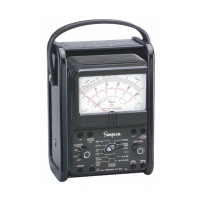
Do you have a question about the Simpson 260 Series 8 and is the answer not in the manual?
| Model | 260 Series 8 |
|---|---|
| Type | Analog Multimeter |
| Category | Measuring Instruments |
| Display Type | Analog |
| DC Current Ranges | 50μA, 1mA, 10mA, 100mA, 10A |
| Resistance Ranges | R x 1, R x 100 |
| Accuracy | ±3% of full scale |
| Input Impedance | 20kΩ/V DC, 5kΩ/V AC |
| Power Source | Battery |
| Battery | 1.5V AA |
Provides an overview of the manual's content and accuracy at the time of writing.
Explains warning symbols and general safety precautions for using the instrument.
Offers contact information for support and details the product warranty policy.
Overview of the Simpson 260 Series 8 Volt-Ohm-Milliammeter, its features, and capabilities.
Details the instrument's protective measures against electrical overloads using fuses and diodes.
Information on the 1.5-volt and 9-volt batteries powering the ohmmeter circuit.
Describes the printed circuit, durable case, and adjustable handle.
Details the provided test leads and introduces the technical data section.
Lists the various DC voltage and millivolt measurement ranges and their sensitivities.
Details the AC voltage and AC output voltage measurement ranges and sensitivities.
Covers DC microampere, milliampere, ampere ranges, and resistance specifications.
Defines accuracy, decibel ranges, battery types, and fuse specifications.
Lists test lead details and instrument dimensions.
Provides the instrument's weight and the maximum rated circuit-to-ground voltage.
Explains how accuracy is expressed and how to select ranges for best results.
Lists essential safety precautions for operating the instrument.
Information about accessory high voltage probe for extending AC voltage range.
Details on using the Amp-clamp for AC current measurements without circuit interruption.
Steps for unpacking, inspecting the instrument, and verifying included items.
Details on the manufacturer's warranty policy and how to obtain service.
Covers internal battery requirements and optimal operating positions.
Detailed explanation of the controls, jacks, and the indicating instrument on the front panel.
Describes the purpose and function of the eight circuit jacks.
Instructions on how to calibrate the pointer to zero for resistance measurements.
Crucial safety warnings and practices to follow during operation to prevent injury.
How to reverse polarity and measure unknown voltages/currents safely.
Guidelines for using test leads and alligator clips effectively and safely.
Step-by-step guide to measuring DC voltage in the 0-1V range.
Detailed procedure for measuring DC voltage in the 0-500V range.
Instructions for measuring AC voltage across multiple ranges, noting waveform effects.
Detailed procedure for measuring AC voltage in the 0-500V range.
Detailed procedure for measuring AC voltage in the 0-1000V range.
How to measure AC component in circuits with both AC and DC voltage levels.
Instructions for performing decibel measurements using the instrument's dB scale.
General safety precautions and procedures for measuring DC current.
Step-by-step guide to measuring DC current in the 0-50μA range.
Procedure for measuring DC current in the 0-10A range.
General precautions and zero adjustment procedure for resistance measurements.
Step-by-step guide for measuring resistance using the instrument.
Guidelines for inspecting the instrument for damage and ensuring safe operation.
Step-by-step instructions for replacing the internal batteries.
Instructions on how to access and replace the instrument's fuses.
Recommendations for inspecting test leads and general instrument care.